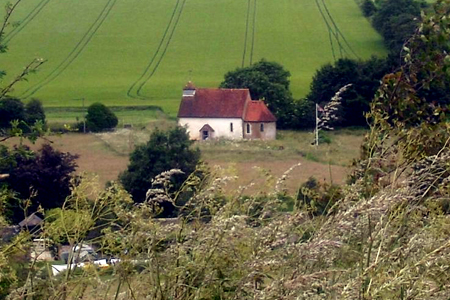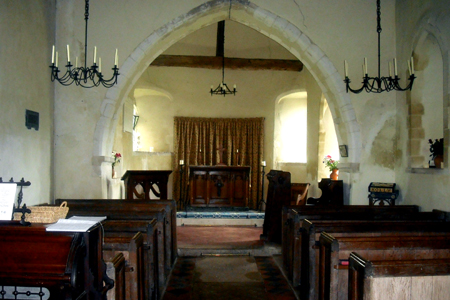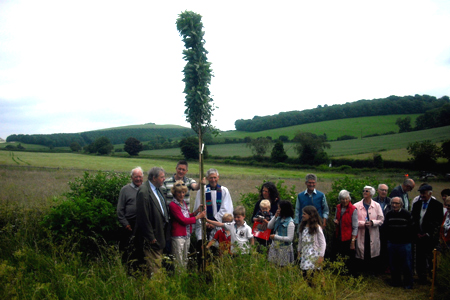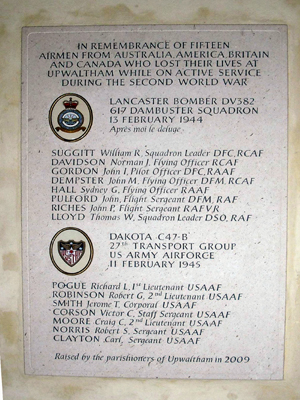| |
 |
 |
 |
| Comment on this report, or find other reports. |
 |
| Our Mystery Worshippers are volunteers who warm church pews for us around the world. If you'd like to become a Mystery Worshipper, start here. |
 |
| Find out how to reproduce this report in your church magazine or website. |
|
|
| 3037: St Mary the Virgin, Upwaltham, England |
 |
 |
 |
Mystery Worshipper: Teutonic Knight.
The church: St Mary the Virgin, Upwaltham, West Sussex, England.
Denomination: Church of England, Diocese of Chichester.
The building: This little "Church in the Field," as it is sometimes called, has served the local community for almost a thousand years. Standing on a hillside in the middle of nowhere, the 12th century early Norman building simply consists of nave and apse, and is one of only three churches in Sussex that have the apse for a chancel. Though there have been some minor alterations over the centuries, none have changed the ground plan or the shape, and it looks still essentially as the builders left it. Its most famous incumbent was Edward Henry Manning, who in 1851 became a Roman Catholic and ended up as Cardinal Archbishop of Westminster. He described the church as "only less beautiful than heaven." The wooden bell cote houses a single bell. There is no east window, and no stained glass except for the beautifully understated west window. There is a large marble slab in the south wall that commemorates the crews and passengers of two wartime air crashes; wreaths are laid every year to honour these fifteen men, seven of whom were US citizens. A flag made up of the national flags of the men who died – UK, USA, Canada and Australia – now flies permanently in the churchyard.
The church: This is the smallest of the three churches that comprise the united benefice of Tillington, Duncton and Upwaltham. It appears that everybody who has ever had any connection with this tiny community brings their own children to be baptised in this place, even if they have to come back from as far afield as Australia. They hold only one service per month here, except in August when there is none. This tradition of no worship in August goes back to the time when agricultural workers were too busy in the fields to go to church. The monthly services, which are also a celebration of community life, usually have a special theme like "Harvest," "Remembrance," "Patronal," "Easter," "Rogationtide," etc.
The neighbourhood: Upwaltham is a tiny hamlet eight miles northeast of Chichester, at the foot of the South Downs National Park, an area of rolling Downland with views of the sea 15 miles to the south. It consists quite literally of only a handful of houses and farms that are home to no more than 20 families. Two long-distance footpaths, the South Downs Way and the Monarch's Way, pass close by. One of these maps the ancient pilgrimís route from Winchester to Eastbourne and Canterbury (of Chaucer's Canterbury Tales fame); the other traces the approximate escape route of King Charles II after his defeat by the Parliamentary Army (the "Roundheads") in 1651. A set of old flint barns has been lovingly restored as a popular wedding venue. Were it not for the A285 motorway linking Chichester with Petworth, this would easily qualify as one of the loveliest spots in all of England.
The cast: The Revd Robert McFarlane Mitchell, priest in charge. Four children helped with the collection.
The date & time: Sunday, 19 June 2016, 11.30am.
What was the name of the service?
Fathers Day Family Service (followed by planting of three flowering cherry trees given by Chichester District Council to commemorate the 90th birthday of HM the Queen).
How full was the building?
Full – just over 40 adults and about 10 children, and some young couples, which really did fill all available pews.
Did anyone welcome you personally?
We were welcomed by several people and were handed a service sheet and hymn book. We chatted to the people in the pew in front, passing the time pleasantly until the vicar was ready.
Was your pew comfortable?
No. Standard small and cramped Victorian, with low back-rests and hardly any legroom, but beautiful thick hassocks – the most recent one embroidered only two years ago and commemorating the beginning of the first World War.
How would you describe the pre-service
atmosphere?
Chaotic and expectant; chatty and friendly. The community had come together for the occasion. Until five minutes before the start of the service, people gathered in the churchyard in waist-high grass and wild flowers. Some people set out collapsible picnic chairs. Two tables were loaded with goods for a ploughman's lunch and drinks. Funny noises emanated from the music machine when it was plugged in. As there is no vestry, the vicar donned his vestments in full view of everyone: cassock with leather belt, surplice, and colourful woven stole. My own vicar back home would have a heart attack if he had to get dressed in public, but the Revd Bob had served as an Army chaplain and was apparently used to the "field" approach.
What were the exact opening words of the
service?
I missed a couple of words in the general din, but the first words I could hear were: "We are pretty full, so well done. Welcome here in Upwaltham for our Fathers Day service."
What books did the congregation use during the
service?
Hymns Ancient & Modern Standard (words edition) and an order-of-service sheet. The lectern Bible was the Good News Bible, which is almost unheard of unusual in these parts.
What musical instruments were played?
There was a wheezy little harmonium that was nevertheless in working order. However, we had music from the can. The vicar, who had rushed over from an earlier service in one of his other churches, set up a small but impressive-looking machine that he carried in a little black case. The gadget sat on the president's chair on the north side of the sanctuary with miles of electric cabling and was remotely operated by the vicar from his prayer desk on the south side. Alas, its volume could not compete with the lusty and full-throated congregational singing – it was almost inaudible except when we ran out of breath.

Did anything distract you?
Just after the vicar had read the banns of two couples, one of those couples slid in at the back. He called out to them, "I've just published the banns. You are safe! There is space here at the front." This caused some hilarity.
Was the worship stiff-upper-lip, happy clappy, or
what?
This seemed to be a style of worship of a bygone age, from before the arrival of Common Worship, and perhaps still based on the Alternative Service Book – of which I have only the vaguest of memories. It was a service of the Word, with a lot of congregational responses, joint responsorial rather than led prayers and collects, and only a short sermon.
Exactly how long was the sermon?
12 minutes.
On a scale of 1-10, how good was the preacher?
8 – The vicar spoke from notes, which he occasionally glanced at, but had a somewhat odd modulation of speech – like putting the emphasis on the first note of a musical phrase. This disconcerted me slightly until I started watching his facial expression rather than merely listening. You could clearly see that there was emotion at work here, that he was sincere in what he was saying, and that the emphasis in the phrase was always on what he cared for most, both in the prayers and the sermon. This was no empty paraphrasing of a theology learnt at college.
In a nutshell, what was the sermon
about?
The reading was Luke 11:1-10: the Lord's Prayer. We were given a quick run-through all the elements of this best-known and most-loved of all prayers. Did Jesus intend this to be a model ritual prayer, or a pattern for prayer? It is perfectly balanced between God, the self, and others; between worship and honouring God through our lives. It holds fear and love in equal tension, and contains all essential ingredients to be conformed to Kingdom values: adoration, worship, supplication, confession, contrition, relationship. It is therefore a template to help us develop our own prayer life and align ourselves with God through Jesus. If our life and prayer, how we relate to God and to others and the world around us, doesn't honour Jesus Christ and follow the Kingdom agenda, it fails the litmus test. If it does, the door to the Kingdom will be opened.
Which part of the service was like being in
heaven?
The sense of this little church being very much at the heart of the small local community.

And which part was like being in... er... the other place?
The musky smell that, even on an early summer's day, permeated every hymn book and wafted up when you turned the pages. On the other hand, if t'other place is merely damp and musky rather than a fiery furnace reeking of sulphur, there are worse places to be.
What happened when you hung around after the service looking lost?
We were swept out into the churchyard along with everybody else to witness the planting of the trees in honour of the Queen's 90th birthday. The children disappeared into the high meadow grass, which was taller than the headstones, while a Spitfire passed overhead from nearby Goodwood Airfield. We had several interesting conversations, including with one of the young couples soon to be married. For a little while we became part of the local community.
How would you describe the after-service
coffee?
Immediately after the ceremonial planting, the corks popped and the ploughman's lunch buffet with delicious home-made pickle was opened. We skipped coffee in favour of the stronger stuff. Finally, a splendid "Queen's Hat" birthday cake covered in purple icing was brought out, together with more cake – and very nice they were, too. Considering that this church is quite literally in the middle of nowhere, albeit with a field for parking at the end of a steep farm track, this was a lavish offering indeed. We could even forgive the paper plates.
How would you feel about making this church your regular (where 10 = ecstatic, 0 = terminal)?
9 – Pity it is a long-ish way from where we live and only has a service once a month. I would need to go elsewhere for a communion service though.
Did the service make you feel glad to be a
Christian?
Very much so. It had a bit of the early church feel about it, when the worship of God together with shared meals were an essential part of community life.

What one thing will you remember about all this in seven days' time?
The short, snazzy, and comprehensive sermon on a subject that is more usually covered in courses lasting weeks or months rather than minutes.
|
|
|
 |
 |
 |
| We rely on voluntary donations to stay online. If you're a regular visitor to Ship of Fools, please consider supporting us. |
 |
 |
 |
| The Mystery Pilgrim |
 |
| One of our most seasoned reporters makes the Camino pilgrimage to Santiago de Compostela in Spain. Read here. |
 |
 |
 |
| London churches |
 |
| Read reports from 70 London churches, visited by a small army of Mystery Worshippers on one single Sunday. Read here. |
| |
|
|
|
|


